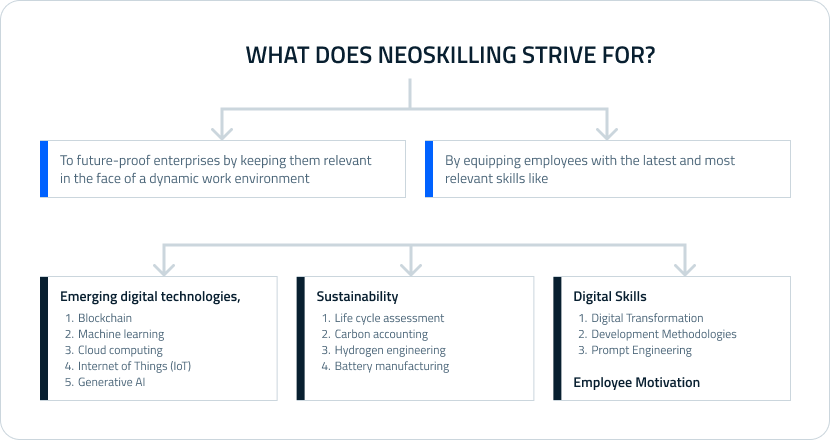

In the ever-evolving world of work, where technologies constantly define the future of work, do upskilling and reskilling remain relevant? How can companies prepare their workforce for tomorrow’s challenges? Read this article to find out.
The knowledge economy is stronger than ever. Knowledge workers constantly enhance existing skills and learn new skills to stay relevant. The Infosys Digital Radar 2023 research1 identifies “building tomorrow’s skills today” as one of the four key principles for successful digital transformation. Business leaders follow “continuous digital learning of employees” as their top practice to meet corporate objectives.
External market trends and internal enterprise requirements together shape the skills an enterprise will need tomorrow. People create value through contemporary skills that match market needs and leverage emerging technologies. How can leaders train their workforce on these skills?
Neoskilling is an innovative approach that future proofs organizations by training the workforce in tomorrow’s skills.2

Neoskilling cultivates higher-order thinking, emphasizes soft skills, and embraces cultural considerations. It comprises proactive development of essential, technology-agnostic skills for an enhanced, dynamic workplace of the future.
The workplace of the future is also an interconnected theme.
Tomorrow’s enterprise will automate repeatable tasks, embrace AI, and empower a skilled workforce to thrive in this hyperconnected world. For instance, generative AI lays the groundwork for a document, and then a human refines it.

The connected enterprise and neoskilling create a symbiotic relationship. Connected enterprises hire and develop tech-savvy employees to take on greater responsibilities. These employees make the enterprise agile and densely interconnected, driving the need for greater neoskilling. The organization receives dual benefits by investing in neoskilling: skilled workforce and enhanced collaborations and innovations.
People now drive value with contemporary skills that scale impact through emerging technologies and match market needs. Neoskilling creates a transformative pathway.

Steps to streamline neoskilling:
1. Identify the skills
How can organizations identify skills for the future? We present multiple approaches in our book2.
- Expand focus beyond your industry to the broader second-order environment.
- Organizations should have gardener, farmer, and forester roles for short-, medium-, and long-term needs and accordingly shortlist the requisite skillsets.
- Create a roles and progression architecture that provide pathways to guide employees who pursue continuous learning.
IDENTIFYING A NEO SKILL
Consider Sustainability.
1. Countries and organizations have announced target years to reduce their carbon emissions and become net-zero. However, the green skills required to achieve a net-zero status are short in supply.
2. Some examples for such skills are
- a. life cycle assessment,
- b. carbon accounting,
- c. hydrogen engineering and
- d. battery manufacturing.
3. LinkedIn witnessed a 20% rise in green job postings in 2022. At the same time, profiles on the portal with at least one green skill grew only 8.4%.3
2. Disseminate the skills
Once identified, organizations should disseminate the skills among employees and establish a learning culture that incentivizes employees to invest in personal growth and development. Mentoring and coaching programs, targeted learning programs, workshops, certifications, rewards and recognition engage learners across the spectrum.
Alongside, leaders must align neoskilling with the organization’s long-term vision to reap its full benefits.
3. Leverage technology
Digital technologies play a key role in low-cost, large-scale skill development.
MOOC (Massively Open Online Course) platforms are the preferred channel for skill development initiatives. AI integration into online learning platforms rapidly disseminates skills through hyper-personalized learning.4 It enables course customization by content, sequence, pace of delivery, and evaluation to suit every student’s learning appetite and objectives.
Gamification of training and bite-sized learning approaches work well for consistent and on-the-move learning.
Loved what you read?
Get practical thought leadership articles on AI and Automation delivered to your inbox


Loved what you read?
Get practical thought leadership articles on AI and Automation delivered to your inbox
The Infosys Future of Work study6 emphasizes that the fastest growing companies automate tools, modernize technology, and reskill workforce to succeed.5 These initiatives add 6.7 percentage points to revenue and 7.7 percentage points to profits. In a connected enterprise, all entities communicate with each other, from people to processes, products, and physical and virtual assets. A skilled and talented workforce is imperative to lead automation and modernization in such an environment. This underlines the necessity for neoskilling.
Neoskilling is not a fad but a paradigm shift that its possible for organizations to transform into connected enterprises, to implement, adopt, and sustain change. A culture of continuous learning keeps enterprises at the forefront of technology, ready for not just current but future challenges and opportunities. The first step begins with neoskilling, and those who adopt will unlock a connected and collaborative future.
Disclaimer Any opinions, findings, and conclusions or recommendations expressed in this material are those of the author(s) and do not necessarily reflect the views of the respective institutions or funding agencies
- Infosys Digital Radar 2023 – https://www.infosys.com/navigate-your-next/research/digital-radar-report.html
- Neoskilling for Digital Transformation, Prof L Prasad, S Ramachandran, Wiley India (2019) – https://www.wileyindia.com/neoskilling-for-digital-tranformation-and-the-artificial-intelligence-revolution.html
- America’s Green Skills Gap Raises Concerns About Energy Transition, Dieter Holger, Wall Street Journal, 2023
- AI and Online Learning, Infosys Knowledge Institute interview with Prof. Anant Agarwal, August 2023XXX
- https://www.infosys.com/iki/videos/ai-online-learning.html
- Infosys Future of Work report – https://www.infosys.com/services/digital-workplace-services/nextatwork.html





